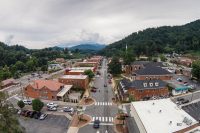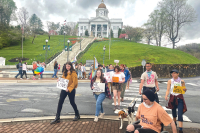Envisioning Sylva’s future: Town leaders talk economy, recreation and civic engagement
 Sylva’s town leaders spent a sunny Saturday indoors armed with pen, paper and heads full of ideas for bringing the small town toward a bright future. And while they may not have left the building with a perfect road map, the four-hour brainstorming session ended with some solid ideas for how to prepare Sylva for success.
Sylva’s town leaders spent a sunny Saturday indoors armed with pen, paper and heads full of ideas for bringing the small town toward a bright future. And while they may not have left the building with a perfect road map, the four-hour brainstorming session ended with some solid ideas for how to prepare Sylva for success.
Town commissioners laid out a vision of a downtown with buildings full of retail and restaurant businesses, their second and third floors renovated to provide in-demand apartment living right in the heart of Sylva. In this ideal future, a cleaned-up Scotts Creek would encounter anglers, paddlers and splashing children on its run through Sylva, and town parks as good as any small town around — perhaps even a skate park for Sylva’s youth — would draw people out-of-doors, with walkable streets making pedestrians abundant.
Aesthetics — power and phone lines buried, aging storefronts renovated, pocket parks prevalent, litter abolished and flowerbeds aplenty — were also at the forefront of the vision. And on the human side, town leaders dreamed of an engaged public — town residents who would come to town meetings, give their input on municipal decisions and take some leadership of their own to make the community the best it could be.
But how to get there?
Arriving at the answer will take far longer than the afternoon board members spent hashing out their ideas, but during that planning session they laid out their next steps for moving the many balls in play further down the court.
Related Items
Growing the tax base
Sylva has long struggled with a shoestring budget that sometime prevents even basic expenditures — like repaving roads in a timely manner — let alone working on wish list projects.
If that’s going to change, board members agreed, they’ll need to work toward growing the tax base, and the key to growing the tax base will be encouraging residential living, with a robust rental market on Main Street’s upper floors as something of a holy grail.
“The more people that you have living downtown and using downtown as their shopping area, the more likely a business will locate there if they know they’ll have a lot of customers,” said Sarah Thompson, planning and development director for the Southwestern Commission, who led the workshop. Thompson is a former Sylva commissioner.
If more people live downtown, Thompson said, then Main Street will naturally shift to include more shopping and dining options, and fewer ground-level professional offices.
The challenge for Sylva is that its downtown buildings are old and many of their upper floors aren’t renovated. Those kinds of renovations are costly.
Commissioner Greg McPherson knows the conundrum firsthand, as he’s the owner of a building downtown with an unfinished floor. He estimates it would cost him about $2 million to renovate.
“I have to make sure … that we (Sylva) are moving forward, always moving forward and not moving backward, before I make that monumental investment,” he said.
Commissioners threw out ideas as to how they might encourage such investment. Maybe there are grants available? Perhaps they could come up with some other way to incentivize building owners? The discussion will likely be one that continues into the future.
And it could be, Thompson said, that Sylva just needs more time for its economy to keep growing, its downtown to keep improving, before it reaches that “tipping point” where building owners feel secure that their investment will pay off.
Tax base growth could extend well beyond the downtown district. Commissioners expressed interest in continuing an ongoing discussion about allowing smaller lot sizes in town. The town requires minimum lot sizes of 0.18 to 0.4 acres per building, depending on which residential district the area is in. Some commissioners think those required acreages are too large, preventing development of more affordable, higher-density housing.
Community engagement
Besides attracting people to Sylva’s city limits, commissioners discussed how to attract the residents it does have to greater town involvement.
Commissioner David Nestler said he’d like to see “more people involved in local politics. Meetings that are full.”
Meanwhile, Commissioner Barbara Hamilton envisioned “a well-run board who … encourages people to step up for leadership roles.”
Thompson encouraged board members in that vision, reminding them that working with community members who show a desire for leadership — rather than trying to operate in a vacuum — can go a long way toward getting things done.
“Don’t feel like you’re up there in town hall operating all alone,” Thompson said.
The group threw out several ideas for engaging the public, getting them familiar with their town government and feeling like they have a stake in it.
Nestler suggested the town begin a monthly litter pick-up, with a rotating schedule so that each month a different commissioner leads it.
That would be “a chance to not only get out there and pick up trash, but meet one of your commissioners,” Nestler said.
What about working with local schools to get kids’ artwork displayed in storefronts downtown — especially during the winter months when reasons to wander downtown are fewer — suggested Commissioner Mary Gelbaugh?
McPherson expressed support for the idea, telling the board what he’s observed following a similar effort at Western Carolina University’s Fine Art Museum, where he works.
“Yesterday I was walking around and there were people that you would never see in an art museum, looking at their kids’ artwork,” he said.
Thompson threw a few other suggestions in the mix, such as periodically moving town meetings offsite to locations people might be more comfortable going to, or developing a “civic academy” for people to come to and learn a little bit about how a town actually operates. Hamilton asked that the board consider shifting its meeting times so they don’t conflict with the Jackson County Commissioners’.
First impressions
Town government should also give some thought to updating its image, commissioners said. That starts with the logo and the website.
McPherson, who’s an adjunct art professor at WCU, said the website looks like “1980s Atari” and is in severe need of revamping. He said the angular mountainscape logo at the top of the page isn’t the most modern either.
He offered to donate his skills as a designer to come up with some logo options for commissioners to consider — the board asked him to present some possibilities this summer — and Thompson suggested that they ask for some cost estimates on redoing the website.
“We already have all the content we want in there,” McPherson said. It just needs an overhaul to improve Sylva’s digital first impression.
Thompson guesstimated it might cost $6,000 to $8,000 to get a site done the town could be proud of.
“It needs to be updated and get a fresh look,” agreed Town Manager Paige Dowling.
Just as the website is the town’s first impression for digital visitors, the road entrances at the Grindstaff and Mill intersection, and at either end of U.S. 23 going through downtown, are the town’s physical first impression. Those need some attending to, board members agreed.
“I think we need much better entrances, real inviting entrances, to town,” Hamilton said.
In addition, Mayor Lynda Sossamon added, improving walkability should be a priority.
In the long-term, added Gelbaugh, it would be great to get power and phone lines downtown buried. They’re a bit of an eyesore, she said.
“It’s absolutely an aesthetic issue,” agreed McPherson.
Commissioner agreed to get someone from Duke Energy to come by their meetings soon to talk about what might be involved in getting that done.
The list of to-dos is a long one, the goals and objectives and notes scattered around the room on giant sticky-notes numerous by the time the meeting was over. But commissioners saw plenty to motivate them, plenty of worthy goals to work toward, papering the wall as they left full of dreams for how to bring Sylva toward its potential.
And, perhaps, better prepared to meet the goal that underscored them all: operating from a cohesive vision, striving for the successful implementation of projects to better the town.
Building parks for teenagers
Improved parks and public spaces got top billing from Sylva’s commissioners as the board brainstormed through its vision for the small town’s future.
Specifically, parks geared toward teenagers. Like, maybe, a skate park or a teen center boasting couches and video games.
“The high school set is someone who’s very bored around here. There’s plenty to do for a little kid and there’s plenty to do for a big kid,” said Commissioner Greg McPherson, but teens are often left hanging.
“They have to have someplace to go,” agreed Commissioner Barbara Hamilton.
Right now, a lot of the teens who hang out in town are at the basketball court over at Poteet Park, but that’s right next to the playground where little kids and their parents go. Sarah Thompson, the Southwestern Commission’s planning director who led the planning meeting, is also a parent who lives in the area. She’s had to scold the teens before for using foul language or smoking cigarettes around the children, she said.
“They don’t have anywhere else to go, but they don’t always mix well with what that park was intended for,” Thompson said.
A skate park could fill the void, commissioners postulated. They admitted, though, that it would also provide some challenges.
“If you had a park where only those kids go, you don’t have any self-regulation,” Nestler said. While curse words might slip and cigarettes might come out at the basketball court by Poteet, he said, having to hang out so close to the little kids might cause the teens to self-regulate more than they would at a skate park.
“We can sit here and josh about those skateboards all we want to, but we also have to talk to our police chief about how you regulate stuff like that,” said Commissioner Harold Hensley.
Hamilton, meanwhile, questioned how much police regulation would need to be involved. From that standpoint, having a skate park might actually be an improvement.
“They have no place to go so they do skate where they shouldn’t sometimes,” she said.
The idea gathered enough enthusiasm for commissioners to support studying it further. They committed to look at possible locations and costs for a skate park, with Thompson reminding them that “skate park” can take many forms, not all of them prohibitively expensive.
“Waynesville put one in that was awesome and expensive and huge. It doesn’t have to be that,” Thompson said. “You can put a skate feature in an existing park and still achieve a little bit of that goal.”
The skate park wasn’t the only project to make it on commissioners’ list of future projects.
They want to fix up Sylva’s three entrances to downtown, make them more welcoming. Water fountains and restrooms downtown would make the town more inviting to tourists. Toward the long-term goal of cleaning up Scotts Creek, fishing piers along its run through Sylva would allow the town to take advantage of all the creek has to offer. And it would be pretty great, commissioner Mary Gelbaugh said, to put in a water feature downtown. Kids love that stuff.
It’s a lengthy list, and the line between which projects become 3D accomplishments and which remain relegated to the world of paper files will likely be determined by the enthusiasm each garners.
“The project that surfaces to the top first is going to be the one that garners the most energy and support,” Thompson said. “If Mary Gelbaugh goes nuts on a water feature — finds the spot for it, finds a grant for it, talks to TWSA (Tuckasegee Water and Sewer Authority) about it, and then y’all are like, ‘Let’s start raising money for it, maybe that one would happen first.
“You don’t have a fluffy enough budget,” she added, “to say, ‘Let’s prioritize these and build them.”
The town’s to do list
In a recent four-hour planning session, Sylva’s commissioners boiled down buckets of daydreams into a few black-and-white goals and objectives for the town.
• Improve, finish and expand town parks. Board members agreed to study the possible locations and cost for a skate park, teen center, water fountains, water feature, public restrooms and fishing piers. They will also keep everyone engaged in the Scotts Creek Watershed Plan they’re working to fund.
• Have the town board operate from a cohesive vision toward successful implementation of projects. Board members will stay actively involved in Jackson County’s comprehensive planning process and strive to be thoughtful, considerate and open as a public body. The board will discuss changing its meeting times in April.
• Develop new logo and website. Commissioner Greg McPherson will provide a possible logo design this summer, and the board will look into the cost of a new website.
• Increase civic participation. The board will organize a community cleanup in April and regularly scheduled cleanups afterward. They’ll also partner with Western Carolina University for a youth art month next year, and organize a December luminaries and quarterly yard sale event.
• Maintain infrastructure well. Needed road improvements will be prioritized, the pedestrian plan will be implemented, and discussions will start with Duke Energy regarding options for burying power lines downtown. A gateway improvement program will be developed and the board will work with the N.C. Department of Transportation to incorporate town plans into future state projects.
• Grow tax base by increasing housing stock. Change ordinances to allow smaller lot sizes, encourage building renovations downtown, identify neighborhoods ready for revitalization and explore possibilities for water and sewer improvements.
• Grow tax base with business development. Create business-friendly ordinances and assert town interests in the Jackson County Economic Development Department.









